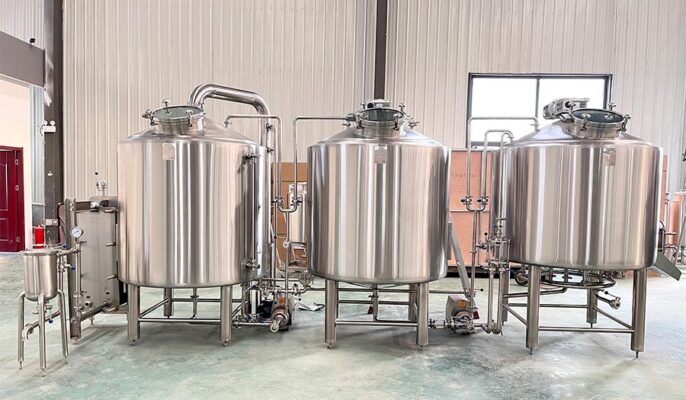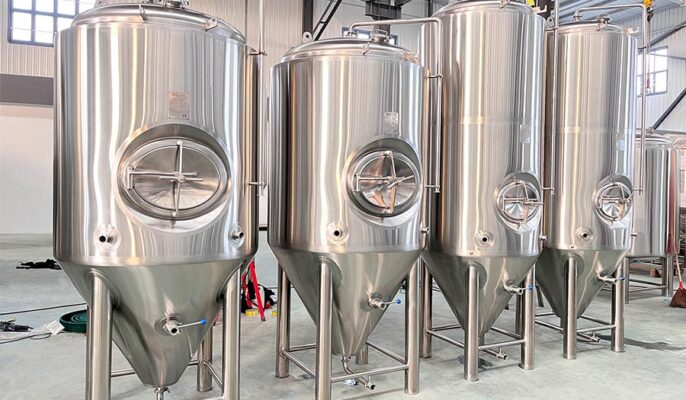Brewing equipment maintenance is critical to ensuring the long-lasting performance and reliability of your brewing unit. Proper care and regular maintenance will not only extend the life of your equipment but will also help improve the consistency and quality of your final brew. In this article, we’ll explore the importance of quality brewing equipment, the various types of brewing tools, best practices for maintaining them, and common problems and solutions.
The importance of maintaining beer brewing equipment
Quality beer brewing equipment is the backbone of every successful beer brewing business. High-quality tools help ensure proper temperature control, reduce the risk of contamination, and enable a more efficient process that produces better-tasting beer. Additionally, well-maintained equipment lasts longer, saving you time and money in the long run.
Soorten apparatuur voor het brouwen van bier
- Brewing Kettle: The brewing kettle is used to heat and boil the wort during the brewing process. They come in different sizes and materials, but stainless steel and aluminum are the most popular options. Keeping your kettle clean and free of rust is crucial for optimal brewing results.
- Fermenter: When the wort is fermented into beer, the fermentation vessel holds the wort. They can be made of glass, plastic, or stainless steel. A well-sealed and sterilized fermentation vessel ensures that no unwanted bacteria spoil your beer.
- Wort Cooler: The wort cooler can cool the wort after boiling, reducing the risk of contamination and odor. They are immersion, counterflow, or plate coolers. Keeping your wort cooler clean and free of debris will prevent clogging and ensure efficient cooling.
- Pumps and Pipes: Pumps and pipes help move liquid throughout the brewing process. Regular cleaning and inspection of these parts ensures smooth, hygienic fluid delivery.

How to maintain beer brewing equipment?
Regular cleaning
Regular cleaning is essential to maintaining your beer brewing equipment. Equipment should be cleaned after each use to prevent the build-up of bacteria, mold, and other contaminants that can affect the quality of your beer.
Desinfecteer
Make sure you sanitize your brewing equipment. Unlike cleaning, disinfection focuses on eliminating any remaining microorganisms. So, it is critical to use a food-safe disinfectant to treat all surfaces that come into contact with your wort or beer. Additionally, always follow the manufacturer’s guidelines for disinfectant solution concentration and contact time.
Regular inspection and maintenance
Regular inspections of your equipment are critical to catching problems before they become major problems. Equipment should be inspected before and after each use to check for any signs of damage, wear, or corrosion. If any problems are discovered, they should be addressed immediately to prevent further damage to the equipment. Repairs should be performed by a qualified technician or the equipment manufacturer to ensure they are done and do not compromise the safety or quality of the equipment.
Beer brewing equipment maintenance
After the heat exchanger has been in operation for a long time or has not been used for a long time, it should be disassembled and cleaned. The cleaned parts should be in place, and the aged sealing gaskets should be replaced in time. check the wiring and grounding conditions of each motor and pump to ensure correct wiring. Pumps used in beer equipment must not be idle or rotated. If pump leakage is found, the pump seals should be replaced in time. Check the oil level of the reduction motor and hydraulic equipment, and add lubricating oil to the mixing motor according to the instructions.
Gistingstank maintenance
- There is air leakage at the joint between the air inlet pipe and the air outlet pipe. If tightening the joint still does not solve the problem, you should add or replace the packing.
- Pressure gauges and safety valves should be checked , and if they are faulty, they should be replaced or repaired in time.
- Electrical equipment such as electrical appliances, instruments, and sensors are prohibited from direct contact with water and steam to prevent them from getting damp.
- When the equipment is not in use, it should be cleaned in time to remove residual water in pipes, tank lids, and hand hole screws to prevent sealing rings from deforming.
- If it is not used , it needs to be drained and the remaining water in the clean water tank and each pipe must be drained.

Tips voor het onderhouden van brouwapparatuur
- If you don’t plan to use your device for a while, make sure you clean it . After the water flow is clear, close the valve. Too, after long-term use, please clean the device before use.
- The heat exchanger should be disassembled and cleaned when it is running for a long time or not used for a long time. Do not use metal brushes during cleaning, and do not bend, twist, step on, or squeeze the heat exchanger plates. Aged sealing gaskets should be replaced in time.
- check the connections and grounding of motors and pumps to ensure correct connections. Check the oil level of the geared motor and hydraulic unit. Add lubricant according to instructions. check the tightness of mixing and tilling accessories. All pumps used must not run idling or , and pump seals should be replaced if leakage is found.
- check whether there are foreign objects and impurities in the hopper of the crusher, check whether the fasteners of the crusher are loose, the tightness of the crusher transmission belt, and the reliability of the safety protection device. Clean the grinding roller .
- check the pressure gauge and safety valve of the steam heating equipment to ensure that the trap is smooth; do not start heating before reaching the specified level. Warning signs should be hung on the top of high-temperature pipes such as steam and wort and saccharification equipment to prevent burns when in operation.
- When filtering, do not extract wort at a large flow rate or damage the sieve plate! When the equipment is not in use, do not place heavy objects on the screen plate to avoid deformation of the screen plate. Keep all mechanical components running during operation.
- Check the plate heat exchanger at any time for leaks, leaks, fluid flow, etc., and repair it immediately if found.
Common Brewing Equipment Questions
To more solve the problem of leaking fittings or seals, routine inspections of brewing equipment are necessary. By inspecting your tools , you’ll identify any loose connections or worn gaskets that could be causing leaks. So, you can take immediate steps to tighten or replace problematic components, thus keeping your brewing process efficient and clean. Also, remember that early detection and prompt repair are critical to preventing more serious problems from occurring.
Pipe or pump clogged
To prevent pipes or pumps from clogging, they must be cleaned and disinfected after each use. By doing this, you will end any potential buildup that could impede the flow of liquid during the brewing process. If there is stubborn debris, use a brush to ensure thorough cleaning. Make it a habit to check your pipes and pumps for any obvious signs of blockage. If you notice any issues, address them immediately to ensure the brewing process runs and .
Rust or corrosion
When it comes to rust or corrosion, it’s crucial to choose brewing equipment made from rust-resistant materials like stainless steel. If you notice rust or corrosion, take immediate steps to clean the affected area. This approach helps protect your device and maintain its integrity.




